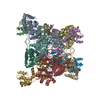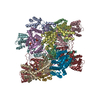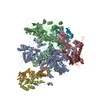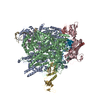+ Open data
Open data
- Basic information
Basic information
| Entry | Database: PDB / ID: 7m9b | ||||||
|---|---|---|---|---|---|---|---|
| Title | ADP-AlF3 bound TnsC structure in closed form | ||||||
 Components Components |
| ||||||
 Keywords Keywords | DNA BINDING PROTEIN/DNA / CRISPR / Transposition / AAA+ ATPase / Tn7 / DNA BINDING PROTEIN-DNA complex | ||||||
| Function / homology | P-loop containing nucleotide triphosphate hydrolases / Rossmann fold / 3-Layer(aba) Sandwich / Alpha Beta / ADENOSINE-5'-DIPHOSPHATE / DNA / DNA (> 10) Function and homology information Function and homology information | ||||||
| Biological species |  Scytonema hofmannii (bacteria) Scytonema hofmannii (bacteria)synthetic construct (others) | ||||||
| Method | ELECTRON MICROSCOPY / single particle reconstruction / cryo EM / Resolution: 3.8 Å | ||||||
 Authors Authors | Park, J. / Tsai, A.W.L. / Mehrotra, E. / Kellogg, E.H. | ||||||
| Funding support |  United States, 1items United States, 1items
| ||||||
 Citation Citation |  Journal: Science / Year: 2021 Journal: Science / Year: 2021Title: Structural basis for target site selection in RNA-guided DNA transposition systems. Authors: Jung-Un Park / Amy Wei-Lun Tsai / Eshan Mehrotra / Michael T Petassi / Shan-Chi Hsieh / Ailong Ke / Joseph E Peters / Elizabeth H Kellogg /  Abstract: CRISPR-associated transposition systems allow guide RNA-directed integration of a single DNA cargo in one orientation at a fixed distance from a programmable target sequence. We used cryo-electron ...CRISPR-associated transposition systems allow guide RNA-directed integration of a single DNA cargo in one orientation at a fixed distance from a programmable target sequence. We used cryo-electron microscopy (cryo-EM) to define the mechanism that underlies this process by characterizing the transposition regulator, TnsC, from a type V-K CRISPR-transposase system. In this scenario, polymerization of adenosine triphosphate-bound TnsC helical filaments could explain how polarity information is passed to the transposase. TniQ caps the TnsC filament, representing a universal mechanism for target information transfer in Tn7/Tn7-like elements. Transposase-driven disassembly establishes delivery of the element only to unused protospacers. Finally, TnsC transitions to define the fixed point of insertion, as revealed by structures with the transition state mimic ADP•AlF These mechanistic findings provide the underpinnings for engineering CRISPR-associated transposition systems for research and therapeutic applications. | ||||||
| History |
|
- Structure visualization
Structure visualization
| Movie |
 Movie viewer Movie viewer |
|---|---|
| Structure viewer | Molecule:  Molmil Molmil Jmol/JSmol Jmol/JSmol |
- Downloads & links
Downloads & links
- Download
Download
| PDBx/mmCIF format |  7m9b.cif.gz 7m9b.cif.gz | 545.2 KB | Display |  PDBx/mmCIF format PDBx/mmCIF format |
|---|---|---|---|---|
| PDB format |  pdb7m9b.ent.gz pdb7m9b.ent.gz | 440.5 KB | Display |  PDB format PDB format |
| PDBx/mmJSON format |  7m9b.json.gz 7m9b.json.gz | Tree view |  PDBx/mmJSON format PDBx/mmJSON format | |
| Others |  Other downloads Other downloads |
-Validation report
| Summary document |  7m9b_validation.pdf.gz 7m9b_validation.pdf.gz | 1.7 MB | Display |  wwPDB validaton report wwPDB validaton report |
|---|---|---|---|---|
| Full document |  7m9b_full_validation.pdf.gz 7m9b_full_validation.pdf.gz | 1.7 MB | Display | |
| Data in XML |  7m9b_validation.xml.gz 7m9b_validation.xml.gz | 94.3 KB | Display | |
| Data in CIF |  7m9b_validation.cif.gz 7m9b_validation.cif.gz | 137.4 KB | Display | |
| Arichive directory |  https://data.pdbj.org/pub/pdb/validation_reports/m9/7m9b https://data.pdbj.org/pub/pdb/validation_reports/m9/7m9b ftp://data.pdbj.org/pub/pdb/validation_reports/m9/7m9b ftp://data.pdbj.org/pub/pdb/validation_reports/m9/7m9b | HTTPS FTP |
-Related structure data
| Related structure data |  23722MC  7m99C  7m9aC  7m9cC  7n6iC M: map data used to model this data C: citing same article ( |
|---|---|
| Similar structure data |
- Links
Links
- Assembly
Assembly
| Deposited unit | 
|
|---|---|
| 1 |
|
- Components
Components
| #1: Protein | Mass: 31444.617 Da / Num. of mol.: 12 Source method: isolated from a genetically manipulated source Source: (gene. exp.)  Scytonema hofmannii (bacteria) / Production host: Scytonema hofmannii (bacteria) / Production host:  #2: DNA chain | | Mass: 8411.627 Da / Num. of mol.: 1 / Source method: obtained synthetically / Source: (synth.) synthetic construct (others) #3: DNA chain | | Mass: 8168.248 Da / Num. of mol.: 1 / Source method: obtained synthetically / Source: (synth.) synthetic construct (others) #4: Chemical | ChemComp-ADP / Has ligand of interest | Y | |
|---|
-Experimental details
-Experiment
| Experiment | Method: ELECTRON MICROSCOPY |
|---|---|
| EM experiment | Aggregation state: PARTICLE / 3D reconstruction method: single particle reconstruction |
- Sample preparation
Sample preparation
| Component | Name: Head to head dimer of TnsC hexamers bound to DNA / Type: COMPLEX / Details: Reconstituted with ADP-AlF3, in closed state / Entity ID: #1-#3 / Source: RECOMBINANT | |||||||||||||||||||||||||||||||||||||||||||||
|---|---|---|---|---|---|---|---|---|---|---|---|---|---|---|---|---|---|---|---|---|---|---|---|---|---|---|---|---|---|---|---|---|---|---|---|---|---|---|---|---|---|---|---|---|---|---|
| Molecular weight | Value: 0.4 MDa / Experimental value: NO | |||||||||||||||||||||||||||||||||||||||||||||
| Source (natural) | Organism:  Scytonema hofmannii (bacteria) Scytonema hofmannii (bacteria) | |||||||||||||||||||||||||||||||||||||||||||||
| Source (recombinant) | Organism:  | |||||||||||||||||||||||||||||||||||||||||||||
| Buffer solution | pH: 7.4 | |||||||||||||||||||||||||||||||||||||||||||||
| Buffer component |
| |||||||||||||||||||||||||||||||||||||||||||||
| Specimen | Conc.: 10 mg/ml / Embedding applied: NO / Shadowing applied: NO / Staining applied: NO / Vitrification applied: YES | |||||||||||||||||||||||||||||||||||||||||||||
| Specimen support | Grid material: GOLD / Grid mesh size: 400 divisions/in. / Grid type: UltrAuFoil R1.2/1.3 | |||||||||||||||||||||||||||||||||||||||||||||
| Vitrification | Instrument: FEI VITROBOT MARK IV / Cryogen name: ETHANE / Humidity: 100 % / Chamber temperature: 277.15 K |
- Electron microscopy imaging
Electron microscopy imaging
| Experimental equipment |  Model: Talos Arctica / Image courtesy: FEI Company |
|---|---|
| Microscopy | Model: FEI TALOS ARCTICA |
| Electron gun | Electron source:  FIELD EMISSION GUN / Accelerating voltage: 200 kV / Illumination mode: FLOOD BEAM FIELD EMISSION GUN / Accelerating voltage: 200 kV / Illumination mode: FLOOD BEAM |
| Electron lens | Mode: BRIGHT FIELD / Nominal magnification: 63000 X / Nominal defocus max: 2500 nm / Nominal defocus min: 1000 nm / Cs: 2.7 mm / C2 aperture diameter: 50 µm / Alignment procedure: COMA FREE |
| Specimen holder | Cryogen: NITROGEN |
| Image recording | Electron dose: 45 e/Å2 / Film or detector model: GATAN K3 BIOQUANTUM (6k x 4k) |
| EM imaging optics | Energyfilter name: GIF Bioquantum / Energyfilter slit width: 20 eV |
- Processing
Processing
| EM software |
| ||||||||||||
|---|---|---|---|---|---|---|---|---|---|---|---|---|---|
| CTF correction | Type: PHASE FLIPPING AND AMPLITUDE CORRECTION | ||||||||||||
| Particle selection | Num. of particles selected: 754099 | ||||||||||||
| Symmetry | Point symmetry: C1 (asymmetric) | ||||||||||||
| 3D reconstruction | Resolution: 3.8 Å / Resolution method: FSC 0.143 CUT-OFF / Num. of particles: 121512 / Algorithm: FOURIER SPACE / Symmetry type: POINT | ||||||||||||
| Atomic model building | Protocol: FLEXIBLE FIT / Space: REAL | ||||||||||||
| Atomic model building | PDB-ID: 6AZ0 Accession code: 6AZ0 / Source name: PDB / Type: experimental model |
 Movie
Movie Controller
Controller














 PDBj
PDBj









































